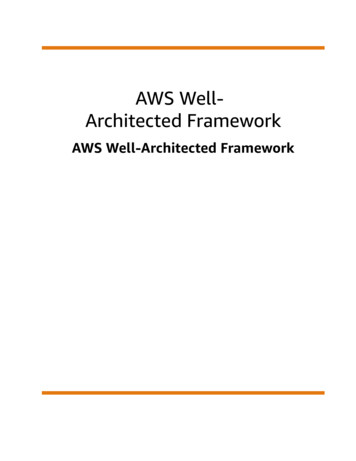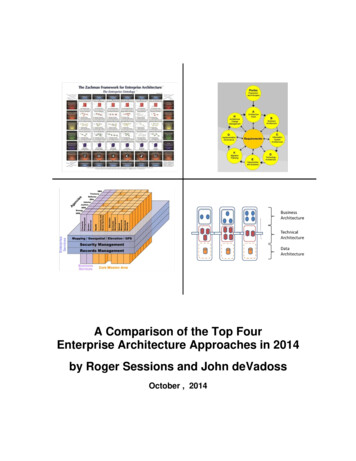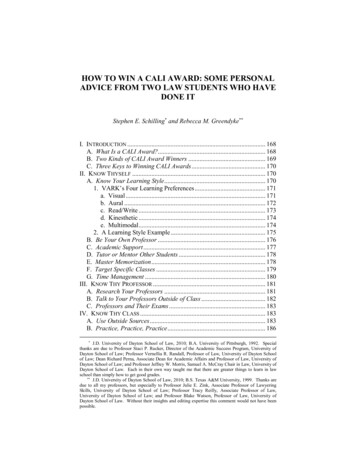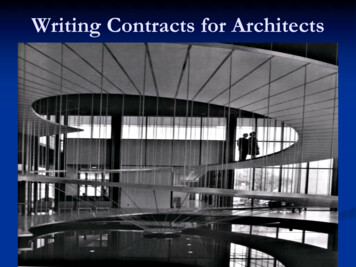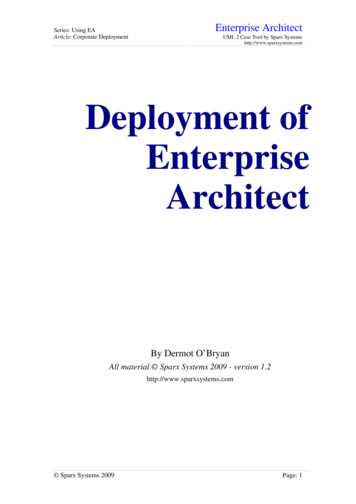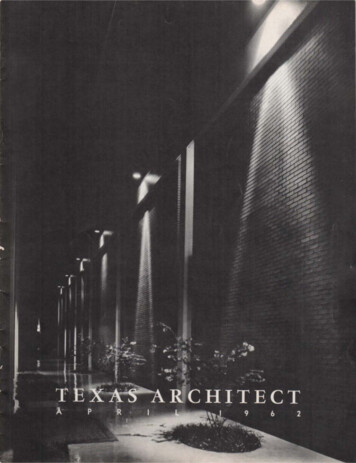
Transcription
Award-winning homedefeats Southwest'sglare anil winilswith modern nHomesProgram.Architect:Petersand Fields,AJAIn this snug desert home in Odessa, Texas, the architect has demonstrated the ability of concrete to fit the needs of design and locale.Patterned concrete masonry walls of the house itself are extended toenfold outdoor living areas. Protection is achieved with highdecorative interest.Used alone or blended with other materials, concrete offerstoday's architects structural efficiency and unlimited design opportunity. Readily formed, textured, colored, patterned to structuralExposed aggregate concrete fireplace addsand decorative ideas, concrete is infinitely versatile . . . truly,the material of modern constructjon. Plan Loenter the 1962 Concrete drama to high-peaked living room. The dis IndustriesHori.t,onHomesProgram.I« }tinctive detailing of interior walls is repeatedwith variations in outdoor areas.110 East Eighth Street, Austin 1, Te osPO RTL ANDCEMENTASSOCIATIONA nationalorgani{ationto improveand extendthe usesof concrete
THE TEXASVol. 12ARCHITECTApril, 1962Number 14Officl I Public.tion ofTHE TEXASSOCIETYOF ARCHITECTSThe TuuRegion I Org niutionofThe Americ.n lnmtvte of ArchitecnDon Edward Legge, A.I.A., EditorJohn G . Flowen, Jr., M n g ing Editor327 Perry-Brools Building, Austin, TeHs""bti,hed n,o thly by tr. Teu, Society of Arc.hae.:hia A slia. S.b&uipt;o. price, 50c per Y . In d IK Copyri9hted 1'51 by tlla T,S.A., Hd till re9 ,tr hon ppl ,ed tor with t U S r.tn1 Oftice.Edilori I contribwlion,, corrospo denco , ud d·vorti1in9 invited by the Editor . Oue to th , n lwroof th publiution,oditori I contribwlions uoo,otbe Pt,1rc11 1ed. PwbUsher qh es permiuioafo, ,.prodwctioe ol J' or put of ed ilori I nwtori Iheroin, d reqwo,h pwbliulioacredit be gi . aTHE TEXAS ARCHITECT, ud .vthor of ,.tori Iwhen indiut ed . ,wbliulioru wh ich nor,.11, yfor ed ltori I ,.torl I ue requosted lo give con·1lde r tion ro the ulhor of rep roduced by-linodfHtur ,.t . :.1.Appur ncoof .,.,., ltd picturH of prodwchud sorvicH ia either editori I copy or d ert,,.ln9 doo, not conslitulo n ondorsemont of umoby e ither the TH Society of Architoch or thoAmerk n Institute of Arch,techTEXAS ARCHITECTURAL FOUNDATION327 Perry Brools Building Austin, TetuTSA OFFICERS FOR 1962Regin ld RobertsRegion I DiredorPresidentH rold E. C lhoun, F.A.I.A.Arthur Fehr, FA.I.A.President EledW lter C. B ,.,.n . . -.'ice PresidentVice PresidentRobert L PetenGeorge F. Pierce , Jr., F.A.I.A. Vice PresidentSecret ry-TreuurerVidcr G. ProbstL W. Pi . FA.I.A.Put PresidentFred J. M cKie, Jr., F.A.I.A.President,Te1H Architectur I Found tionbeculive DirectorJohn G. Fl-ers Jr.TSA DIRECTORS FOR 1962Abllene CtwipterWood lief F. BrownBretos ChapterTheo R. Hollem nGeorge M. P geCenlr I TeHs Ch pterCo.st I S.nd Ch pterRobert J. BHsleyD lles Ch pterGeorge F. HurellEl Puo Ch pterLou,s DHubie, Jr.Ft. Worth Ch plerJoseph J. P ttenonHouston Ch plerM ce Tung teLR.G.V. Ch pterZ.b RikeLubbock Ch.pterJohn S. Stu.rtNorth Tuu Ch pler .P ul J. Pond Jr.North Eu! Ch pler0. L HetelwoodP nh ndle Ch pterJohn S. Werd, Jr.S n Antonio Ch pler H rv y V M rmon, JrSouth Eut Tetu Ch plerOouglu E. Steinm n, Jr.West TeHs Ch plerW lt r L Norrisen' !::.RTexas Architect's cover is a minorentrance court that dramatizes therhythmic s1mphcity of the TexasArchitecture award winning DowCenter of Hou ston designed by Caudill, Rowlett and Scott.The President 's LetterHAROLD CALHOUN, FAIAPresidentTexas Society of ArchitectsAll members of the Texas Society of Architects are grateful to thestaff of A & M College, and most particularly , to Ben Evans, SeminarChairman Theo Holleman, and the entire faculty for the excellentprogram 'Creative Architecture Through Research, a Workshop onBuilding Technology," held last month in the Memorial StudentCenter, College Station. More than forty architects and forty students participated in one of the most informative and challengingprograms ever presented to the TSA membership . Several of thenationally prominent speakers who have participated in other areaconferences pronounced this the finest of its character ever held Itwas, of course, a pioneering effort, and by unanimous vote of theassemblage it will be repeated in 1963 with a far richer and moremeaningful program of work Agam , may we soy that our gratitudegoes to those who organized. planned and administered this excellent conferenceBut now our attention is focused upon the exciting prospects of theAJA Convention to be held m Dallas, May 7-11. President PhilipWill, Jr., F.AI A., has announced that the theme of this year's convention will be ' New Dimensions of Architectural Practice ." DeanCharles R. Colbert, Columbia University , will give the keynote address entitled "The Social Dimension of Design" Following DeanColbert will be Jane Jacobs. associate editor of Architectural Forumand author of the provocative book "The Death and Life of GreatAmerican Cities," and Mayor Ben West of Nashville, Tennessee.The second program session, entitled "New Dimensions of Architectural Knowledge," will be chaired by Douglas Haskell. editor ofArchitectural Forum and assisted by Karl Fallc, economist and president of the National Association of Housing and RedevelopmentOfficials; internahonally known Los Angeles architect WilliamPere ira, and Paul Opperman, executive director of the NortheasternIllinois Metropolitan Area Planning Commission .The third program. entitled ''Case H1stones of Community Services,"chaired by Emerson Goble, editor of Architectural Record, will dealwith proiects in Little Rocle, Arkansas , Knoxville . Tenne!'lsee, andEugene Oregon.The fourth program session 1s entitled "Case H,:.tones of ExpandedServices," chaired by Thomas Creighton, editor of Progressive Architecture, will explore in depth an individual building project involving expanded architectural services.New films to be shown at the convention include "An Architect atWorlc" and "Form , Design and the City ." A full program of socialevents, awards and professional performances and the traditionalinvestiture of new AJA Fellows will complete what should be oneof the outstanding AJA Convention programs of oil time . We, inTexas, are extremely pleased to be the official hosts of the AJA andcan best demonstrate professional interest by being present for theentire convention.3
1962 marks the completion of ten years of existence of the Texas Architectural FoundaJion. The charter in fact, was granted on June 4, 1952. Itseems appropriate, therefore, at this time to review the progress made andthe current status of the TA F.TEXASARCHITECTURALFOUNDATIONThe business affairs of the Foundation are accomplished by a Board ofTrustees, composed of the current President of the TSA and the five immediate living Past Presidents, plus the head of one of the five Schools ofArchitecture. The Trustees are assisted by a Board of Directors consistingof the Presidents of the sixteen TSA Chapters and the other architecturalschool heads. But the fundamental concern of furthering architectural education in Texas makes the Foundation the business of every architect in Texas.The charter of the Foundation provides specific purposes for which theFoundation is created:"The purpose for which this Corporation is formed is to providefor the support of an educational undertaking by aiding andfurthering the study of architecture and by providing financial aid,grants, or scholarships to selected individuals to so do; and, to receive, manage, expend, and sell property for funds to carry out thepurposes above stated."No part of the earnings of this corporation shall inure to any individual and no part of its activities shall be to carry on propagandaor to influence legislation . "To accomplish these high aims the Foundation has administered a numberof important funds supplied by industrial and educational organizations interested in the furtherance of architectural education in Texas .TEXAS AIICHITECT
M. D. ANDERSON FOUNDATIONI he mo:;t recent grant 1s from the M. D. AndersonFoundation, which will be expended for the first timein 1962. The terms of tlw, program call for:"Grant is to be administered by the TexasArchitectural Foundation, of hvc ThousandDollars per year ( One Thou! and Dollar, peryear to be granted to each of the five Schoolsof Architecture), for a period of three to fiveyears. to allow for continuity of researchprograms ! elected by the director of eacharchitectural school. In admin.-.tering such aresearch grant the rexas Architectural Foundation would submit an annual report to theM . D. Anderson Foundation, covering eachprogram, ,elected b)' the schoob "Jl ·SSl H . JONES SCHOL ARSII IPI h.-. excellent scholar-.h1p program provided by theOlliecrs and Trustees of the Hou,ton Lndowment Incorporated and called the Jesse H . Jones Scholarships.makes available three g1ants of 1,000.00 each toworthy and qualified applicants from the five Schoolsof Architecture in Texas. The qualification" call forevidence of genuine need and demom,trated high ,chota,t1c capabilities through four yea,., of training inSchools of Architecture by students who possess outstanding moral character and arc dedicated to a careerin architecture . 'J he first three scholarship grants weremade at the annual TSA Convention in 1961.f l· A I HERl I rl · COMPI 1 ITION·r he Fcathcrhte Competition ,., om: of the olde,t inthe history of the I oundat1on and b an award madeto the five Schools of Architecture based upon probterm subnuttcd during the course of the normal curriculum in each school. Three grants are made to each,chool each year and total fond of 2,500.00 1s available for this purpose through the generosity of theFeatherlile CorporationMONARCH TILC SCHOLARSHIPSrwo excellent scholar,h1p awards totaling 1,000.00arc made through the generosity of the Monarch TileCompany, with applications open to all Schools ofArchitecture in Texas. Applicants for the grunt under' land that it "can be awarded only to one whose intention to make the profession of architecture his lifeendeavor. is ,inccre, whose character and reputationcommand re-.pcct in hb community, whose qualification-. and achievement-. have demon,trated outstandingability m his chosen field."CLAY PRODUCfS A WARDThis excellent program for years was in the form ofa compet1t1on but has recently been ch.1nged to providea fund of 1,500.00 to be used a-,, emergency assistanceto students in the five Schools of Architecture as determined by the head, of each school. It is anticipatedthat receipts of these funds will be expected, in thefuture, to repay the scholarship grant at such tune ashe is ableTEXAS GRANITE COMPANYThe Texas Granite Company intends to make available 500.00 to be used in a similar fashion.TEXAS CONCRETE MASONRYASSOCIATION AWARDSThis As-,ocialion makes available 750.00 to beawarded in recogn1t1on of de.,.gn excellence during thefourth year of education. Nominations for individualgrants arc made by the heads of the several Schoolsof Architecture to the Foundation.OTHER PROGRAMSThe I·oundat1on has received requests for assistancein many projects, and despite its limited funds has beenable to provide a large number of scholar-,hips to ass1'tteachers or architecture school-. to attend the annualsummer training sc s1onssponsored by the AIA-ACSAheld in various part, of the country.The I oundataon has aho helped underwrite thepubl1cat1on of a scholarly book by a professor on thefaculty of Rice University.The l·oundat1on has also underwritten two guc,tlecture programs at the ftve Schools of Architecture andhas provided for a traveling exhib1uon to he shown atall of the 'tchools.The OOicers and Trustee, of the Foundation havelong rcgrelled that many more worthwhile progra1mcould not oe provided But while the !'mwth of thef oundation has been constant and gratifying, it IHI',not ,cached a point where income from investment,could prcn,1desulhc1ent mcomc IO augment the alre.1dyex1' tmgprogramsWhere does the money corn!.! from'? TI1e aboveaward,, scholarships and competitions arc all providedby private mdu,try The balance of the activities of theFoundation arc underwriuen b1 the genero,ity of practicing architects who have developed the re!;!ular habitof giving l ach of the Trustees donates 100 00 a yearfor each of the six years of his ,ervice on the BoardSeveral sub' tantial memorial donation, have been m.1dcin the names of well known deceased architects. Otherarchitect, have budgeted a regular annual contributionin their own name or the names of their firm,;. lhcseveral Women's Architectural 1 eague chapters haveraised money through a variety of projects and havecontributed most generously.Final!)', the ,inglc most efTecuve me.ins of rai,ingmoney has been through the receipt of gifts in the formof memorial contributio ns honcmng deceased friendsand relatives. Several individuals find themselves nrnking monthly contributions in lieu of flowers or oth-:rrecognition at funerals.It is still every practicing architect's responsibility tonurture the well springs of the profession. In short, ifthe roundation 1s to continue to grow and pro-,pcr andserve an ever larger role m architectural education inTexas, more people must find 11a regular habit to giveoften and to give generous ly to the Texa, Architectu1 alFoundallon.s
tA paper presented at the annual Convention of the TexasSociety of Architects, Fort Worth, Texas, November 9-10,1961.ARCHITECTSCREATIVITYThe characteristics of creative architects which Ishall describe and whose implications for architecturaleducation I shall discuss have been noted in an intensive study of three nation-wide samples of the profession.The first of these groups, which I shall call ArchitectsI, were 40 architects, each of whom had been nominated by a panel of professors of architecture at theDONALDW. MA CKINNO NInstitute of Personality Assessmentand ResearchUniversity of California,Berkele y6TEXAS ARCHITECT
University of California for the unusual creativenesswith which they practice architecture. They were 40out of a larger sample of 64 invited to submit themselves to intensive study in our Institute at Berkeley.They came, ten at a time, spending three days with us,participating in a series of experiments, psychologicaltests, and interviews covering the life history and professional career. These assessments yielded for eachparticipant a multiplicity-literallyhundreds-ofmeasures, scores, ratings, and recorded impressions, all ofwhich have been intercorrelated to reveal what goeswith what in the life histories and personality structuresof these architects. And each measure, in turn, hasbeen correlated with independently obtained ratings ofthese architects' creativeness.Though we cannot claim to have studied in thissample the 40 most creative architects in the country,we can with assurance assert that we were privilegedto study a highly creative group who, as a group, itmay be noted , were, in their degree of creativity, undistinguishable from the 24 who declined to be assessed.But to have limited our study to Architects I, thehighly creative, would not have permitted us to sayanything with confidence about the personality correlates of creativity; for the distinguishing characteristics of these architects might well have nothing to dowith their creativity. A representative sampling of theentire profession might reveal that the traits of thehighly creative characterize all architects, distinguishingthe professional group as a whole but in no sensedistinctive of its highly creative members.To sample the profession more widely, Dr. WallaceB. Hall, co-director of the study, searched the Directoryof Architects ( 1955) for two additional samples, bothof which would match the 40 highly creative individualsof Architects I with respect to age and geographic location of practice. The first of these supplementarysamples, which I shall designate as Architects II, iscomposed of 43 architects each of whom met stillanother requirement, namely, that he had had at leasttwo years of work experience and association with oneof the originally nominated creative architects. Theother additional sample, which I shall label Architects111, is composed of 41 architects none of whom hadever worked with any of the nominated creative architects.By selecting three samples in this manner we hopedto tap a range of talent sufficiently wide to be fairlyrepresentative of the profession as a whole, and weappear to have succeeded. For when subsequently sixgroups of architectural experts!! undertook to rate on a!!The six groups of raters were the five members of the originalnominating panel for Architects I, six editors of the majorarchitectural journals, 19 professors of architecture distributednation-wide, 32 Architects 1, 36 Architects 11, and 28 Architects Ill.Al'IIIL, 19629-point scale the creativity of each of the 124 architects( 40 Architects I, 43 Architects II, and 41 ArchitectsIII) whom they knew well enough to judge, the averageor mean rating of creativity for each of the three groupswas significantly different from the average rating ofthe other two. The average rating for Architects I was5.46, 4.25 for Architects II, and 3.54 for Architects III.Having demonstrated that the three groups do indeedrepresent significantly different levels of creativity, wecan examine data obtained from them to discover thepersonality correlates of creativity and more specificallythe distinguishing characteristics of creative architects.Creative architects are intelligent. On a difficult, highlevel test of verbal intelligence ( the Terman ConceptMastery Test), they earn an average score of 113(equivalent to an average IQ of about 130), scoringas a group five points below research scientists in industry and 12 points above undergraduate students. Buttheir individual scores range widely from 39 to 179,and within this creative group the correlation of intelligence as measured by this test and creativity inarchitecture as rated by the experts is -.08, not significantly different from zero.Since I have been widely misquoted on the relationbetween intelligence and creativity, let me say to youwhat I have often said about this lack of relationshipbetween intelligence and creativity among Architects I.Certainly this finding does not mean that over thewhole range of creative endeavor there is no relationbetween intelligence and creativity. We discovered nofeeble-minded creative architects. Clearly a certaindegree (and in general a rather high degree) of intelligence is required for creativity, but beyond thatlevel, being more or less intelligent is not cruciallydeterminative of the level of an architect's creativeness.In general, creative architects have IQs well aboveaverage. But for an individual architect to be recognizedfor his creativity does not require that he be outstandingin intelligence, and conversely, a very high IQ does notguarantee that he will be creative.Unfortunately we have no adequate measure of theintelligence of Architects II and 111. Since they did notcome to Berkeley for intensive assessment, but rathercompleted at home a selection of our tests, questionnaires, and inventories which could be self-administered,it was not possible to obtain direct measures of theirintelligence. Thus we do not know whether more creative architects are as a group more intelligent or lessintelligent than their less creative colleagues or in noway different on this dimension.On an indirect measure of intelligence, a measure ofintellectual efficiency, Architects I, II and III are, however, not significantly different from each other.At the very least, these findings suggest that measuredintelligence is a fallible predictor of creativity, and that7
if students with creative potential for architecture areto be early identified, factors other than or at least inaddition to intelligence must be considered.Creative architects in school were good students but,in general, not outstanding in academic achievement.For the total sample of 124 architects there is zerocorrelation between their rated creativity and theirgrade point average both in grade school ( · .02) andin high school ( · .08). In college for the first timethere is a positive and significant correlation betweengrades and subsequently rated creativity in the profession, but the relationship is a low one, ·-.27.The failure of academic grades to predict more effectively the ultimate level of creativity may stem in largepart from the nature of the achievement motivation ofcreative architects in contrast to that of their less creative colleagues.Architects I, II and I II all show a strong drive toachieve m an independent fashion, but Architects I,the highly creative architects, arc markedly less inclinedthan their colleagues among Architects II and Ill tostrive to achieve m any setting where conformance isrequired and rewarded. Since, despite all that may besaid to the contrary. college instructors do tend to setrather definite requirements for their courses and todemand rather strict conformance to them, studentswho e motivation is largely to achieve in unique andindependent ways may often enough be downgraded.Still another reason why grade point average is notmore highly correlated with creativity is that thoughcreative architects could tum in an A performancein courses that interested them, in courses that failedto strike their imagination they were quite willing todo little or no work at all.Furthermore, they were often quite critical of whattheir instructors offered them. One of them who wasfailed in his design dissertation which attacked thestylism of the faculty, ended by taking his degree inthe art department. There is clear evidence that thesestudents of high creative potential were often difficultto put up with and required of their instructors anunusual degree of tolerance and understanding.As for the implications of these and of other finding;still to be reported, we must remind ourselves that thedistinguishing traits of creative workers observed severalyears after college may not have characterized thesesame individuals when they were undergraduates. Norcan we be certain that finding these same traits in theundergraduates of today will idenufy those with creative potential. Only empirical research can answerthat question. But considering the nature of the traitswhich best discriminate creat1ves from non-creativcs,I would venture to guess that most creative students aswell as students with creative potential will show profiles and patterns of traits and psychological preferences congruent with those of our creative subjects, thoughoften with less extremescores.Architects, as I have suggested elsewhere,:'' representin any study of creative species a hybrid breed, havingto be at one and the same time exemplars of bothartistic and scientist creativity. You have simultaneouslyto combine, reconcile, and exercise the diverse skillsof artist, businessman, engineer, and advertising man,not to mention psychologist, author-journalist,psychiatrist, and educator. One might, then, wonder ifarchitects as a group would not reveal that which ismost generally characteristic of creativity and the creative person. For that reason we chose your professionfor study, and I suspect that for the same reason noneof the standardized tests administered to architects produced so many significant predictors of their creauvityas did the Strong Vocational Interest Blank whichmeasures the similarity of a subject's expressed interests with the known interests of successful personsin a variety of occupations and professions. Scores on40 of the 57 scales of this test correlated significantlywith rated creativity, ranging from Artist which correlated · .59 to Banker which correlated -.66. Out ofthe 40 significantly correlated scales six which correlated highly and represented five of the 11 vocationalinterest groups of the test were selected for derivationof a multiple regression equation which gives optimalweight to each score, so that in combination they predict the criterion of creativity better than any one ofthem will do alone. These scales and their individualcorrelations with the criterion are Artist · .59, Authorjournalist · .54, Masculinity-femininity (high scores indicative of masculinity) -.48, Policeman -.52, Officeman -.60, Banker -.66. Together, in the multiple regr ssion equation, they predict the criterion of creativity · .7 I.Since scores on the Vocational Interest Blank arequite early stabilized, utilization of the test with specialreference to those scales which best predict creativityin conjunction with other data should improve selectionof students, if, as I am assuming, you wish to discoverthose with creative potential.The meaning of the pattern of scores on the SVJBwhich predicts creativity is quite clear: the more creative architects are less interested in small detail, infacts as such, and more concerned with their meaningsand implications, possessed of greater cognitive flexibility and wider interests including many which in ourculture would be thought of as feminine, and characterized by verbal skills and interests as well asaccuracy in communicating with others.If highly creative architects are distinguished fromtheir less creative colleagues by their interests, one11MacKinnon,D W. 1961. Crea1ivity in architects. A paperpre,-ented 10 the Conrerence on Creativi1y. Un1ver\lly ofCalirornia Alumni Cenler, Lake Tahoe, California, O :tober13- 17, 1961.TEXAS OCHITECT
might imagine that their values would also differ; andStudy ofthey do. On the Allport-Vemon-LindzeyValues designed to test in the individual the relativestrength of six values-the theoretical, economic, aesthetic, social, political, and religious values-ArchitectsIscore highest on aesthetic and theoretical, and despitethe success with which. as entrepreneurs, they carry outtheir architectural practice, their least valued value isthe economic.Aesthetic and theoretical values are also the twohighest values for Architects II and III, but thesevalues are less pronounced for them. Furthermore. theeconomic value, the lowest of all values for the highlycreative architect, is held significantly higher by Architects I I and III Indeed, m the total sample of 124, thetheoretical value correlates with the rated creativity ofthe architects .18, the aesthetic value .35, and theeconomic value -.48. Here, then, is another test worthyof tryout in any experimental test battery designed toidentify creati"e potential in would-be students of architecture.Creativity is certainly associated with, if not dependent upon. a wide perceptiveness and openness to richness and complexity of experience. On the BarronWelsh Art Scale of the Welsh Figure Preference Test,which presents a subject with a set of 62 abstract linedrawings ranging from simple and symmetrical figuresto complex and asymmetrical ones. the task being tosort the drawings into two piles-liked and dislikedartists show a marked preference for the complex andasymmetrical. non-artists a clear preference for thesimple and symmetncal.On this scale Architects I earn a mean score of 37 .1,te ling very clo to the artists who scored 39. l. In contrast Architects II score 29.5, Architects III 26.1. Aclosely related finding is that in the total sample ofarchitects, scores on an Institute scale which measurespreference for perceptual complexity correlate .48with rated creat1\1ty. Here, then, are two more candidates for inclusion in an experimental test battery.In view of the findings just reported one would expect that on a test designed to determine an md1vidual's preference for percepuon (becoming aware ofsomething) or for judgment (coming to a conclusionabout something}, creative architects would show apreference for perception. They do. In the total sample,preference for perception correlates with rated creativity r.41, preference for judgment -.29.As between two kinds of perception, sense-perception (a direct becoming aware of things by way of thesenses) vs. intuitive-perception (an mdirect perceptionof the deeper meanings and possibilities inherent inthings and situations) one would expect creative architects to be on the side of intuition. They are. In thetotal sample, preference for intuitive perception correlates -r .45 with rated creativity, preference for senseperception -.41. The Myers-Briggs Type Indicatorwhich measures these preferences is still another promising device for the early identification of creative potential.On the Califomia Psychological Inventory, a test designed to measure the more positive interpersonalaspects of behavior, Architects I reveal themselves asdominant; possessed of those qualities and attributeswhich underlie and lead to the achievement of socialstatus; poised, spontaneous, and self-confident in personal and social interaction, though not of an especiallysociable or participative temperament. They are intelligent, outspoken, sharp-witted, demanding, aggressive, and self-centered, persuasive and verbally fluent,self-confident and self-assured; and relatively uninhibited in expressing their worries and complaints. Theyshow themselves, also, as relatively free from conventional restraints and inhibitions, not preoccupied withthe impression which they make on others and thusperhaps capable of greater independence and autonomy, and relatively ready to recognize and admitself-views which are unusual and unconventional. Theyare strongly motivated to achieve in situations in whichindependence in thought and action are called for, butas I indicated earlier, they are less inclined to strivefor achievement in settings where conforming behavioris expected or required. In efficiency and steadiness ofintellectual effon they do not dif
The fourth program session 1s entitled "Case H,:.tones of Expanded Services," chaired by Thomas Creighton, editor of Progressive Archi tecture, will explore in depth an individual building project involv ing expanded architectural services. New films to be shown at the convention include "An Architect at

